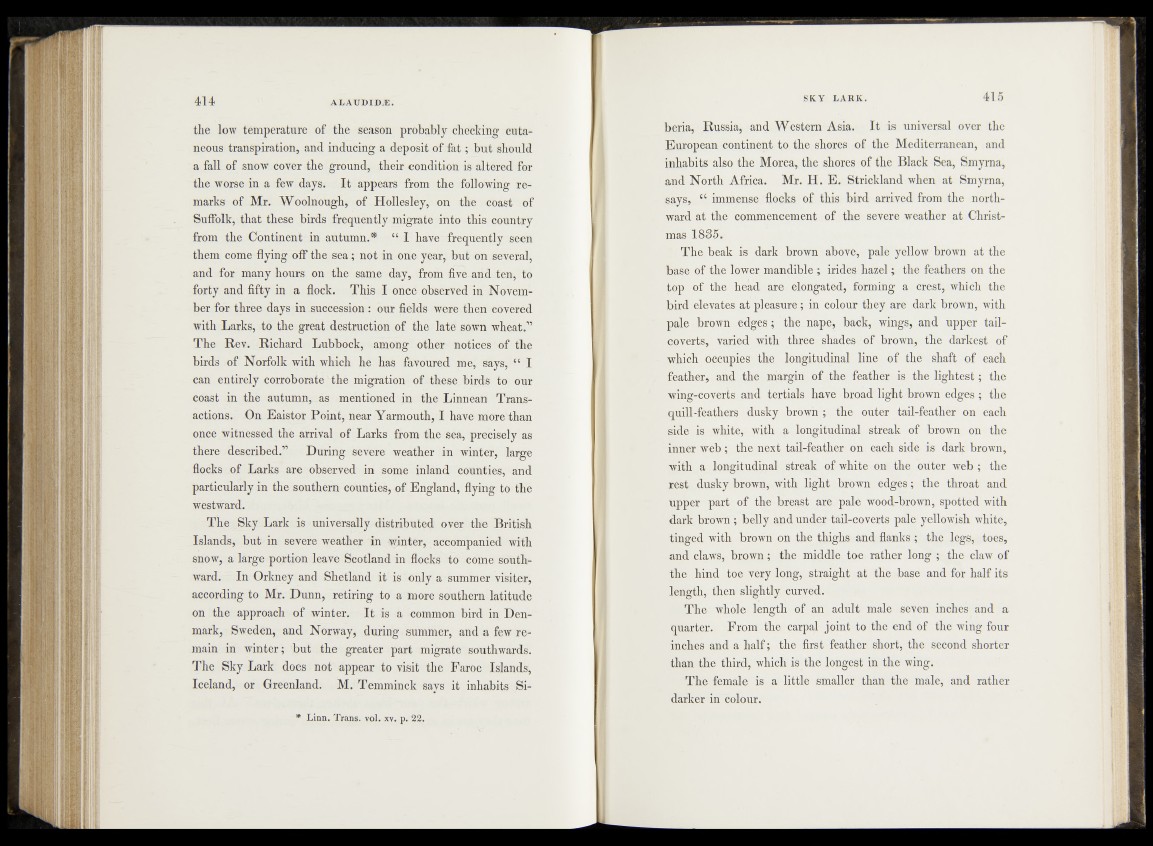
the low temperature of the season probably checking cutaneous
transpiration, and inducing a deposit of f a t; but should
a fall of snow cover the ground, their condition is altered for
the worse in a few days. I t appears from the following remarks
of Mr. Woolnough, of Hollesley, on the coast of
Suffolk, that these birds frequently migrate into this country
from the Continent in autumn.* “ I have frequently seen
them come flying off the sea; not in one year, but on several,
and for many hours on the same day, from five and ten, to
forty and fifty in a flock. This I once observed in November
for three days in succession: our fields were then covered
with Larks, to the great destruction of the late sown wheat.”
The Rev. Richard Lubbock, among other notices of the
birds of Norfolk with which he has favoured me, says, “ I
can entirely corroborate the migration of these birds to our
coast in the autumn, as mentioned in the Linnean Transactions.
On Eaistor Point, near Yarmouth, I have more than
once witnessed the arrival of Larks from the sea, precisely as
there described.” During severe weather in winter, large
flocks of Larks are observed in some inland counties, and
particularly in the southern counties, of England, flying to the
westward.
The Sky Lark is universally distributed over the British
Islands, but in severe weather in winter, accompanied with
snow, a large portion leave Scotland in flocks to come southward.
In Orkney and Shetland it is only a summer visiter,
according to Mr. Dunn, retiring to a more southern latitude
on the approach of winter. It is a common bird in Denmark,
Sweden, and Norway, during summer, and a few remain
in winter; but the greater part migrate southwards.
The Sky Lark does not appear to visit the Faroe Islands,
Iceland, or Greenland. M. Temminck says it inhabits Si*
Linn. Trans, vol. xv. p. 22.
beria, Russia, and Western Asia. It is universal over the
European continent to the shores of the Mediterranean, and
inhabits also the Morea, the shores of the Black Sea, Smyrna,
and North Africa. Mr. H. E. Strickland when at Smyrna,
says, “ immense flocks of this bird arrived from the northward
at the commencement of the severe weather at Christmas
1835.
The beak is dark brown above, pale yellow brown at the
base of the lower mandible ; irides hazel; the feathers on the
top of the head are elongated, forming a crest, which the
bird elevates at pleasure; in colour they are dark brown, with
pale brown edges ; the nape, back, wings, and upper tail-
coverts, varied with three shades of brown, the darkest of
which occupies the longitudinal line of the shaft of each
feather, and the margin of the feather is the lightest; the
wing-coverts and tertials have broad light brown edges ; the
quill-feathers dusky brown ; the outer tail-feather on each
side is white, with a longitudinal streak of brown on the
inner web; the next tail-feather on each side is dark brown,
with a longitudinal streak of white on the outer web ; the
rest dusky brown, with light brown edges; the throat and
upper part of the breast are pale wood-brown, spotted with
dark brown ; belly and under tail-coverts pale yellowish white,
tinged with brown on the thighs and flanks ; the legs, toes,
and claws, brown; the middle toe rather long ; the claw of
the hind toe very long, straight at the base and for half its
length, then slightly curved.
The whole length of an adult male seven inches and a
quarter. From the carpal joint to the end of the wing four
inches and a half; the first feather short, the second shorter
than the third, which is the longest in the wing.
The female is a little smaller than the male, and rather
darker in colour.